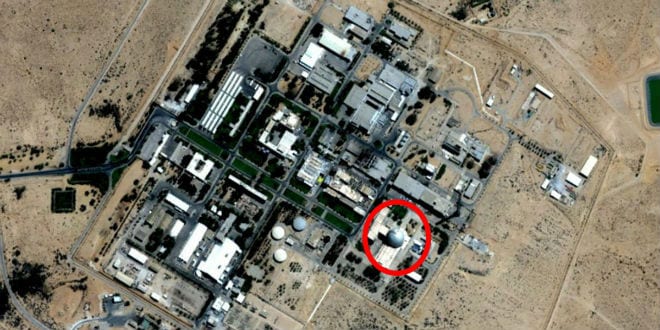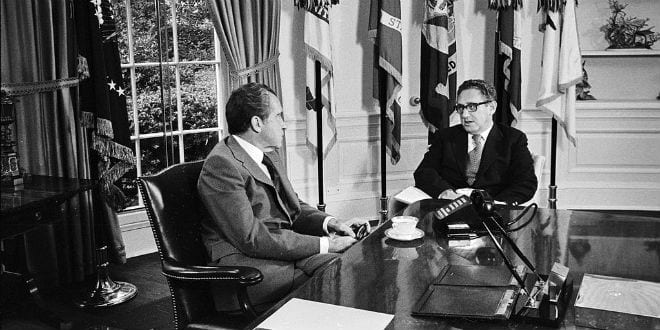Recently declassified documents from the Nixon era show the US was anxious about Israel’s nuclear program and sought to pressure the Jewish state into signing the Treaty on the Non-Proliferation of Nuclear Weapons (NPT), reported The Times of Israel. To this day, Israel has not signed the treaty and maintains a policy of ambiguity regarding its nuclear capabilities.
According to the paper, the 1,100-page report covers meetings from 1969-1976 and details American strategy on Israel’s program. It is particularly fascinating coming as it does just weeks after the US, along with five other world powers, reached a controversial accord with Iran to curb the Islamic Republic’s nuclear program.
The documents reveal a vested interest in preventing Israel’s nuclear program from becoming public knowledge, as well as disagreements between the various security departments on how to proceed.
A July 19, 1969 memorandum from then-national security adviser Henry Kissinger to President Richard Nixon showed all parties, the Joint Chiefs of Staff, Department of Defense, and State Department, were eager for Israel to sign the NPT, though they did not agree on whether weapons should be withheld as a means of forcing Israel’s hand. While the Joint Chiefs of Staff and Department of Defense wished to condition the delivery of Phantom jets on Israel’s acceptance of the NPT, the State Department opposed using the jets as leverage.
The memo outlines the dilemma of hinging weapons delivery on Israel signing the NPT. “Our problem is that Israel will not take us seriously on the nuclear issue unless they believe we are prepared to withhold something they very much need — the Phantoms or, even more, their whole military supply relationship with us,” it said.
“On the other hand, if we withhold the Phantoms and they make this fact public in the United States, enormous political pressure will be mounted on us. We will be in an indefensible position if we cannot state why we are withholding the planes. Yet if we explain our position publicly, we will be the ones to make Israel’s possession of nuclear weapons public with all the international consequences this entails.”
For his part, Kissinger expressed that keeping the program a secret was more important than stopping it, as “public knowledge [of Israel’s nuclear program] is almost as dangerous as possession itself.
“What this means is that, while we might ideally like to halt actual Israeli possession, what we really want at a minimum may be just to keep Israeli possession from becoming an established international fact,” he wrote.
Kissinger noted that while ideally Israel should sign the treaty by the end of the year, it may not impact their actual nuclear program.
“Everyone agreed that, as a minimum, we want Israel to sign the NPT. This is not because signing will make any difference in Israel’s actual nuclear program because Israel could produce warheads clandestinely,” the memo said. “Israel’s signature would, however, give us a publicly feasible issue to raise with the Israeli government — a way of opening the discussion. It would also publicly commit Israel not to acquire nuclear weapons.”
Additionally, the US sought “a bilateral understanding on Israel’s nuclear intentions because the NPT is not precise enough.”
The Joint Chiefs of Staff, Department of Defense and State Department did not necessarily share the same perspective on the US position regarding Israel’s nuclear program. The Joint Chiefs of Staff “felt that if Israel’s program becomes known, we should be in a position to say we did everything in our power to prevent Israel from going nuclear,” while the Department of Defense said, “we could live with the existence of Israeli nuclear weapons provided they were not deployed.”

The State Department, meanwhile, believed “we should try to keep Israel from going any further with its nuclear weapons program — it may be so close to completion that Israel would be willing — and make a record for ourselves of having tried.”
The US also wished to halt Israel’s Jericho missile program, as it felt no non-nuclear use for the missile was apparent to justify its continued development.
In an effort to convince Israel to sign, a meeting of then-ambassador to the US Yitzhak Rabin with Deputy Secretary of Defense David Packard and Acting Secretary Elliot Richardson was encouraged. “If Rabin tried to stonewall, Richardson and Packard would state exactly what we want and make clear that Israeli unresponsiveness would raise a question about our ability to continue meeting Israel’s arms request,” Kissinger suggested.
A memo from Nixon approved Kissinger’s plan three days later, but “specifically withheld authority to link explicitly at this stage the delivery of conventional weapons to the Israeli response on the nuclear question.”
According to the documents, the meeting took place July 29 of that year. There, Rabin repeated the official Israeli position, expressed by ex-Prime Minister Levi Eshkol, that Israel was reviewing the treaty and would make no further comment. According to the minutes, he added that “he wanted to make clear that he was not accepting the US assumption that Israel has the capability to build nuclear weapons. He could say neither that Israel was capable nor that it was not.”
In another memorandum from Kissinger to Nixon, this one dated October 1969, Kissinger seems resigned to the fact that Israel was not going to sign the NPT any time soon.
“What we have to settle for, I believe, is an Israeli commitment that will prevent Israeli nuclear weapons from becoming a known factor and further complicating the Arab-Israeli situation,” he wrote. He then offered an alternative, which “would in effect ask the Israelis to accept privately the key obligation of the NPT while allowing them more time to sort out their position on more generally unpalatable aspects of the treaty (e.g. safeguards and public renunciation of the nuclear option).”
Nixon approved.




